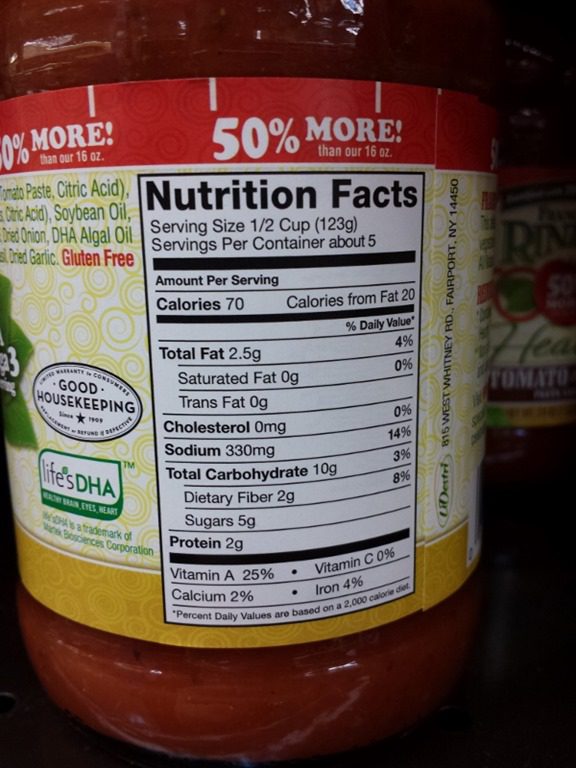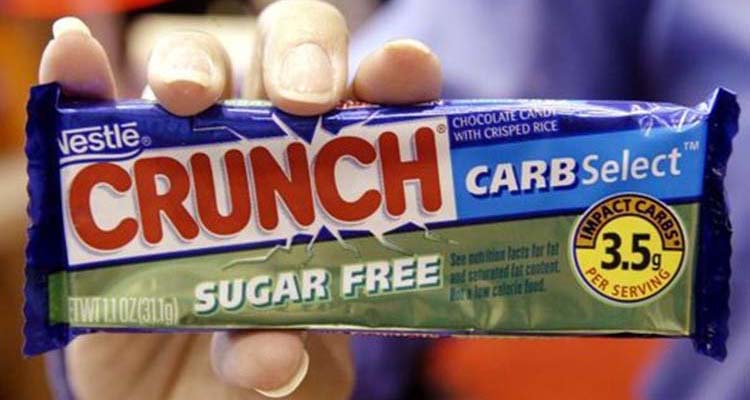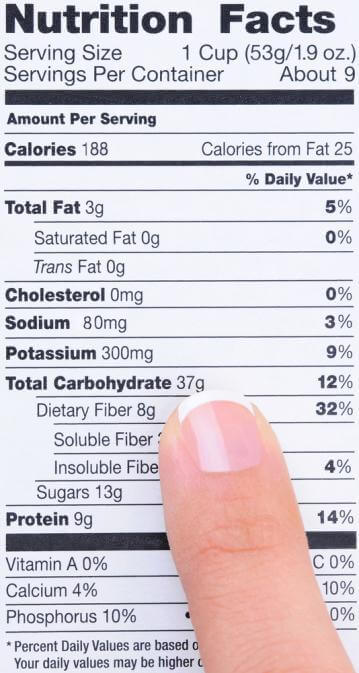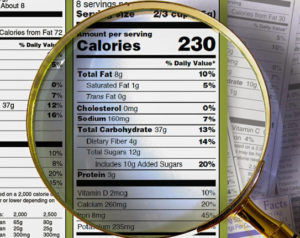42 how to read food labels for sugar content
How to Read Nutrition Labels: Fat Content, Carbs & What To Look For Sugar Alcohols may be labeled simply as such or may be called out by their individual names like polyol, erythritol, sorbitol, xylitol, etc. A clue that a substance is a sugar alcohol is if it ends in "-ol". You may also see the term "allulose" listed in the carbohydrate section of a label. Sugars on food labels - Sugar Nutrition Resource Centre Polys or sugar alcohols are naturally found in some fruits and used commercially in products such as chewing gum. Packaged foods in Australian and New Zealand must provide nutrition information on the labels, including ingredients, nutrition information panels and content claims. Food Standards Australia New Zealand (FSANZ) are the regulatory ...
How to Read Food Labels and Understand Sugar Content - yum. Gluten Free In particular, how to read a food label to determine the amount and type of sugar in a product. To achieve the above, we'll provide an introduction to label reading; a useful skill that applies to any packaged food product. The key food label components we'll look at include the Nutrition Information Panel (NIP) and ingredient list. I hope the below information assists in your understanding of food labels and the sugar content in foods. Let's get started!

How to read food labels for sugar content
Sugar Savvy: How To Read Food Labels - Elsa Jones < 5g of sugar per 100g = low sugar content. 5g - 15g sugar per 100g = medium sugar content >15g of sugar per 100g = high sugar content . Note Re. Naturally Occurring Sugars. If you're trying to calculate sugar content on a food label, it's important to bear in mind that in many cases, not all of what you see is 'added sugar'. Added Sugars on the New Nutrition Facts Label | FDA Labels for foods and beverages with added sugars will list the number of grams and the percent Daily Value (%DV) for added sugars within the Nutrition Facts label. Having the word "includes" before... How to Understand and Use the Nutrition Facts Label | FDA It's important to realize that all the nutrient amounts shown on the label, including the number ...
How to read food labels for sugar content. Reading Food Labels | ADA - American Diabetes Association The Nutrition Facts labels on foods are really the key to making the best choices. We'll cover the basics so that these labels make shopping easier for you. You've heard it all. From carb-free to low-carb, to whole and empty carbs, it's hard to know what it all means. Blood sugar highs and lows aren't always easy to understand. How to read labels for added sugar - That Sugar Movement Look past the clever marketing and fancy health claims on the packaging and learn how to read labels and identify added sugars. Here is our three-step guide on how! One: Look for foods under 5g total sugar/100g. In Australia, the Nutrition Information Panel (NIP) on the back of food and drink packaging lists total sugars content. How Much Sugar Should You Eat in a Day? The Experts Explain The recommendation for men is no more than 9 tsp. of sugar or 150 calories from added sugar daily and for women and kids 6 tsp. sugar and 100 calories daily," says Shapiro. When talking about ... How To Easily Read The Sugar Content On A Food Label Here's the calculation: (this calc is not perfectly exact but close enough to use as a general rule) 1) Check out the nutritional label on any food packaging and find the amount of total carbohydrate in grams 2) Add the Sugars and Carbs together 3) Subtract the fiber grams. If the fiber is less than <1 gram it may not be listed.
How to understand food labels - Eat For Health Sometimes labels will include nutrition content claims like 'low fat', 'reduced salt' or 'high fibre'. These claims can only be used if the food meets certain criteria. For example, with a 'good source of calcium' claim, the food must contain more than a set amount of calcium. While nutrition content claims can generally guide ... Food labels - NHS Some front-of-pack nutrition labels use red, amber and green colour coding. Colour-coded nutritional information tells you at a glance if the food has high, medium or low amounts of fat, saturated fat, sugars and salt: red means high. amber means medium. green means low. Understanding Food Labels | The Nutrition Source | Harvard T.H. Chan ... These statements describe the nutrients in a food beyond what is listed on the Nutrition Facts label, intended to showcase a health benefit of the food. An example is "Contains 100% Vitamin C.". Most terms like "low sodium," "high fiber," "reduced fat," and "good source of" are regulated by the FDA, and the nutrient amounts ... Reading food labels: Tips if you have diabetes - Mayo Clinic Put sugar-free products in their place. Sugar-free doesn't mean carbohydrate-free. Sugar-free foods may play a role in your diabetes diet, but remember that it's equally important to consider carbohydrates as well. A sugar-free label means that one serving has less than 0.5 grams of sugar.
Food Labels | CDC If you eat the whole thing, you are eating 8 times the amount of calories, carbs, fat, etc., shown on the label. Total Carbohydrate shows you types of carbs in the food, including sugar and fiber. Choose foods with more fiber, vitamins, and minerals. Choose foods with lower calories, saturated fat, sodium, and added sugars. How To Read Food labels for Sugar | My Sugar Free Kitchen 3 Simple Steps For Understanding Food Labels Get familiar with the different names for sugar. It comes in all forms and guises! Here are some names for sugar... Fructose, Glucose, Sucrose, Maltose, Agave nectar, beet sugar, brown sugar, confectioners sugar, cane sugar, caster... Read the ingredients ... Learning To Read Labels - Diabetes Education Online When you read food labels, the grams of sugar are already included in the total carbohydrate amount, so you do not need to count this sugar amount separately. The grams of sugar listed include both natural sugars, from fruit or milk, and added sugars. On a nutrition food label, the total carbohydrate includes the sugar. Some Nutrition Facts labels may also list sugar alcohols under total carbohydrate. How to Read Food Labels Without Being Tricked - Healthline The product may contain very little whole grains. Check the ingredients list — if whole grains aren't in the first three ingredients, the amount is negligible. Fortified or enriched. This ...
Understanding Food Nutrition Labels | American Heart Association Remember that the information shown in the label is based on a diet of 2,000 calories a day. You may need less or more than 2,000 calories depending upon your age, gender, activity level, and whether you're trying to lose, gain or maintain your weight. When the Nutrition Facts label says a food contains "0 g" of trans fat, but includes ...
How to Read a Food Label | Atkins Wrong! Look carefully at the Nutrition Facts label and you will see that a single serving is calculated not as 20 ounces but as eight ounces. You are expected to share that bottle with a friend and a half! That means that all those calculations about carbohydrate content, sugar content and calories are for only eight ounces, not the whole bottle.
Understanding food labels - Diabetes UK Check the ingredients list - if syrup, invert syrup, cane sugar, molasses or anything ending in 'ose' is within the first three ingredients, this suggests the food contains more added sugar. Choose an alternative if possible, or be mindful of the portion you eat. Check the fibre content on the back of pack label.
How To Read Food and Beverage Labels | National Institute on Aging At the top of the Nutrition Facts label, you will find the total number of servings in the container and the food or beverage's serving size. The serving size on the label is based on the amount of food that people may typically eat at one time and is not a recommendation of how much to eat. Read more about serving and portion sizes.
This Is How to Read a Nutrition Facts Label on the Keto Diet That's not a 33% fat, 33% carb, 33% protein ratio. It's actually 52% fat, 24% carb, 24% protein. This may sound a little confusing, but as long as you limit carbs (the most important part) and aim for healthy fats and protein to make up a majority of your daily macronutrient intake, your results should be excellent.
Understanding sugar content on food labels - Diabetes Care Community On a food label, the total amount of carbohydrate in grams is listed first. This number includes starch, sugars and fibre. Fibre does not raise blood sugar levels and should be subtracted from the total carbohydrate. Say, for example, one serving of food contains 36 grams of carbohydrate, which includes 6 grams of fibre.

Try and get your sugar from ðŸðŸŽðŸðŸŠðŸ“ðŸ‡ðŸ‰ðŸŒðŸ’ðŸ‘ðŸðŸˆ! It's imperative to read food labels! Using this app ...
How to Read Carbohydrates on Food Labels - GlycoLeap The information listed on 'Per 100 g/ml' column is to make it easy to compare it with similar products. The numbers in the 'Per 100 g/ml' column are also the same as percentages. For example, if 20 g of added sugar is listed in the 'Per 100 g/ml' column, this means 20% of the product by weight is added sugar.
How to Identify Sugar on Nutrition Labels | Days To Fitness Step 3 - Compare the sugar content of similar food products. A very effective way to see how much sugar is in the food you are eating is to compare product labels side by side. For example, take a no-added-sugar cereal and a regular breakfast cereal and compare total sugar per same-sized serving. You'll often be surprised at the difference.
How to read food labels: MedlinePlus Medical Encyclopedia The total carbs (carbohydrates) are listed in bold letters to stand out and are measured in grams (g). Sugar, starch, and dietary fiber make up the total carbs on the label. Sugar is listed separately. All of these carbs except fiber can raise your blood sugar.
How to Understand and Use the Nutrition Facts Label | FDA It's important to realize that all the nutrient amounts shown on the label, including the number ...
Added Sugars on the New Nutrition Facts Label | FDA Labels for foods and beverages with added sugars will list the number of grams and the percent Daily Value (%DV) for added sugars within the Nutrition Facts label. Having the word "includes" before...
Sugar Savvy: How To Read Food Labels - Elsa Jones < 5g of sugar per 100g = low sugar content. 5g - 15g sugar per 100g = medium sugar content >15g of sugar per 100g = high sugar content . Note Re. Naturally Occurring Sugars. If you're trying to calculate sugar content on a food label, it's important to bear in mind that in many cases, not all of what you see is 'added sugar'.











Post a Comment for "42 how to read food labels for sugar content"